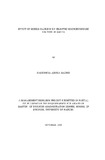| dc.description.abstract | Mobile banking is the provision of banking services using handheld devices such as palmtops, mobile phones and personal digital assistants. Mobile banking is a relatively new technology which is being adopted at a rate. Macroeconomic factors are such factor that are pertinent to a broad economy at the regional or national level and affects a large population rather than a few select individuals. Macroeconomic factors such as Inflation, savings and investment are key indicators of economic performance and are closely monitored by government, businesses and consumers. With improvement of mobile technologies and devices, banking users are able to conduct banking services at any place at any time. Recently, many banks in the world have provided mobile access to financial information. Understanding the various macroeconomic factors that contribute to user’s intention to use mobile banking is an important issue. The objective of this study was to determine the effect of mobile banking on selected macroeconomic factors in Kenya. Secondary data of all 44 commercial banks in Kenya was used for the study and collected from banks annual report for three years (2007-2009). The number of customers registered for the mobile banking service was regressed against three variables namely savings, investment and inflation. The results of the study were analyzed using Statistical package for social studies (SPSS Version) where different data were analyzed in form of tables, pie charts and graphs. The findings indicated that inflation rate was 11.62% for the 3years.Savings had very low standard deviation hence indicates that most banks within three years had almost the same savings as Central Bank of Kenya and the average number of mobile customers was 544225 people. Findings also showed that savings and investment increasing from 2007-2008 with 37% of banks had accounts having less than 250,000 account holders in 2009, 37% of banks had accounts less than 250,000 in 2008 and 37% of banks had account numbers less than 200,000 holders in 2007. In conclusion there was no direct relationship between effect of mobile banking and the selected macroeconomic factors that is inflation, savings and investment. | en |

